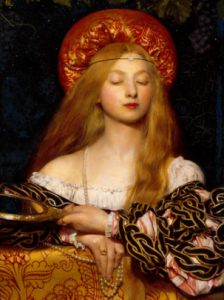Savonarola
Savonarola was Stanford’s second completed opera after the Veiled Prophet. It was written as a grand opera in the French style with a prologue and three acts. Like the Veiled Prophet, it was premiered in Germany and only presented in German in both Germany and England.
The opera’s Prologue set in Ferrara, Italy in 1475 , tells how the young Savonarola is forced to leave his lover Clarice because of his father’s disapproval. He decides to become a monk. The action in the subsequent three acts takes place in 1498 when Savonarola has become de facto ruler in Florence. A group of citizens led by Rucello and including Clarice’s daughter, Francesca, plot to overthrow him. Francesca’s hatred for Savonarola dissolves, however, and she changes sides.
One of Savonarola’s followers , Sebastiano, falls in love with Francesca , but she is devoted to Savonarola and spurns him. Sebastiano is killed defending his leader. Although Rucello’s plot is foiled, Savonarola’s days are numbered. He is captured and burned at the stake. Francesca watches his death and dies in a state of heavenly ecstasy.
The work requires a huge chorus, opulent costumes and scenery and contains rivalries, passions and spectacle.
Savonarola was premiered in Hamburg in German on April 18th, 1884. It was also given in German in London by the German Opera Company on July 9th, 1884. The libretto was by Gilbert A’ Beckett ,who also wrote the libretto for Stanford’s third opera, The Canterbury Pilgrims. The opera received good reviews from the German press but the reception of the London production was only lukewarm. One of the problems was that because of a copyright dispute with Boosey & Co the libretto was only available in German in gothic script, which most of the audience could not understand. The opera has not been revived since 1884.
Downloadable Scores and Audio
| Full and Vocal Scores | ||
|---|---|---|
| Full Score Part 1 | 16.4/01A | Download Full Score Part 1 [11 x 17] |
| Full Score Part 2 | 16.4/01B | Download Full Score Part 2 [11 x 17] |
| Full Score Part 3 | 16.4/01C | Download Full Score Part 3 [11 x 17] |
| Vocal Score | 16.4/02 | Download Vocal Score [8.5 x 11] |
| Digital Audio File(s) | |
|---|---|
| 1. Prologue [NotePerformer 4 mp3] | Download/Play Audio |
| 2. Overture & Act I [NotePerformer 4 mp3} | Download/Play Audio |
| 3. Act II [NotePerformer 4 mp3} | Download/Play Audio |
| 4. Act III [NotePerformer 4 mp3} | Download/Play Audio |
| Note: Parts have not yet been prepared and will be undertaken if/when an organization expresses interest in programming the work. |

